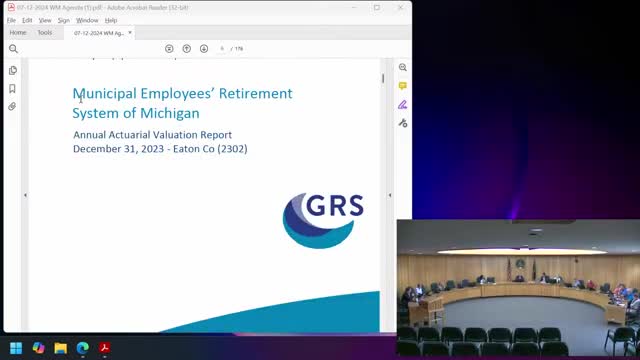Pension funding crisis threatens local services and jobs
July 13, 2024 | Eaton County, Michigan

This article was created by AI summarizing key points discussed. AI makes mistakes, so for full details and context, please refer to the video of the full meeting. Please report any errors so we can fix them. Report an error »

During a recent government meeting, officials discussed the annual valuation of the Municipal Employees Retirement System (MERS), revealing that the pension funding level stands at 61%, just above the critical 60% threshold. This figure is significant as it determines eligibility for state aid packages. The meeting highlighted the historical fluctuations in funding percentages over the past two decades, emphasizing the challenges posed by market volatility and investment strategies.
Officials noted that while the actual investment return was 10.94%, the smoothed return used for budgeting purposes was only 5.54%. This smoothing process is designed to mitigate the impact of market fluctuations, but it means that the benefits of recent investment gains will not be fully realized for several years. The required contributions for the upcoming budget cycle will be based on the 2022 valuation, which accounts for 32.5% of the total general operating revenue.
Concerns were raised about the long-term implications of strict funding requirements, with officials warning that excessive pressure to achieve full funding by 2038 could lead to significant cuts in non-mandated services. This sentiment was echoed in discussions with state legislators, who were informed about the potential consequences of stringent funding mandates on local municipalities.
The meeting concluded with plans for a representative from MERS to address the board in August, as officials seek to explore options for extending the funding timeline and incentivizing communities that make difficult financial decisions. The discussions underscored the need for a balanced approach to pension funding that considers both fiscal responsibility and the sustainability of local services.
Officials noted that while the actual investment return was 10.94%, the smoothed return used for budgeting purposes was only 5.54%. This smoothing process is designed to mitigate the impact of market fluctuations, but it means that the benefits of recent investment gains will not be fully realized for several years. The required contributions for the upcoming budget cycle will be based on the 2022 valuation, which accounts for 32.5% of the total general operating revenue.
Concerns were raised about the long-term implications of strict funding requirements, with officials warning that excessive pressure to achieve full funding by 2038 could lead to significant cuts in non-mandated services. This sentiment was echoed in discussions with state legislators, who were informed about the potential consequences of stringent funding mandates on local municipalities.
The meeting concluded with plans for a representative from MERS to address the board in August, as officials seek to explore options for extending the funding timeline and incentivizing communities that make difficult financial decisions. The discussions underscored the need for a balanced approach to pension funding that considers both fiscal responsibility and the sustainability of local services.
View full meeting
This article is based on a recent meeting—watch the full video and explore the complete transcript for deeper insights into the discussion.
View full meeting
